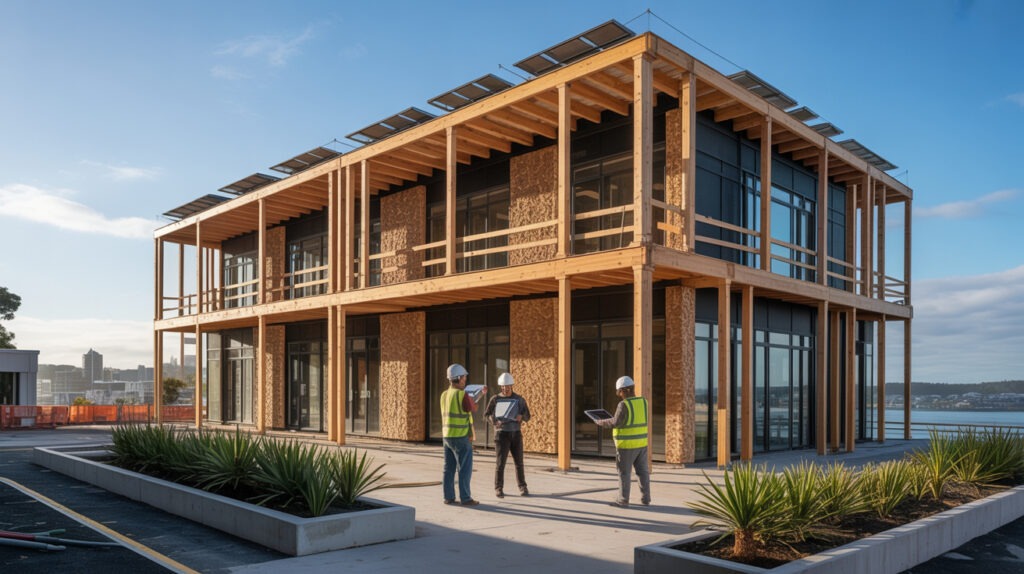New Zealand, or Aotearoa, is a nation deeply connected to its stunning natural environment. With a strong commitment to combating climate change, the country has set ambitious goals, including reaching net-zero carbon emissions by 2050. The construction industry, a significant contributor to national emissions through both embodied carbon (emissions from material production and construction) and operational carbon (emissions from a building’s energy use), is at the forefront of this crucial transition. In 2025, the sector in NZ is not just talking the talk; it’s actively implementing strategies and embracing innovations to meet its part of these vital net-zero commitments.

A Shifting Landscape: New Regulations and the Drive for Transparency
The year 2025 marks a pivotal moment for the New Zealand construction industry. Starting this year, mandatory carbon counting for new buildings is being enforced. This means that to obtain building consent, projects now require a detailed report outlining their embodied and operational carbon footprint. This isn’t just a bureaucratic exercise; it’s a strategic move by the government to drive transparency and accountability, laying the groundwork for specific carbon caps to be introduced from 2026 to 2030.
This regulatory shift is a powerful incentive for architects, engineers, and builders to meticulously consider the environmental impact of every design choice and material selection. It’s forcing a deeper dive into Environmental Product Declarations (EPDs), which provide verified information on the environmental performance of building materials. Companies that can demonstrate low-carbon options with robust EPDs are gaining a significant advantage, as those without might face higher costs or compliance risks. This has sparked a surge in demand for low-carbon materials and innovative design approaches that prioritize circularity and deconstruction.
Also Read: AI in Construction: A New ‘Power Tool’ for Smarter, Safer Sites in Australia and NZ
The Material Revolution: Building with Less Impact
At the heart of reducing embodied carbon is a fundamental shift in material selection. New Zealand’s construction sector is increasingly moving away from traditional high-carbon materials like conventional concrete and steel, embracing a range of innovative, lower-impact alternatives.
- Cross-Laminated Timber (CLT) and Mass Timber: New Zealand, with its abundant sustainably managed forests, is a natural fit for mass timber construction. CLT and other engineered wood products are renewable, sequester carbon, and offer excellent structural performance. They are becoming increasingly common in larger commercial and multi-residential buildings, showcasing a viable alternative to concrete and steel frames. This isn’t just about wood; it’s about a carbon-storing, rapidly renewable resource taking center stage.
- Hempcrete and Bio-Based Materials: The interest in hempcrete (a mixture of hemp shiv, lime, and water) is growing steadily. Known for its insulating properties, breathability, and impressive carbon sequestration abilities, hempcrete is an exciting frontier for residential and some commercial applications. Beyond hempcrete, other bio-based building materials like straw bales, mycelium composites, and even recycled agricultural waste are being explored and adopted, reducing reliance on virgin, energy-intensive resources.
- Low-Carbon Concrete Innovations: Recognising that concrete will remain a foundational material, significant research and development are focused on low-carbon concrete. This includes using supplementary cementitious materials like fly ash, slag, or even locally sourced volcanic ash (pumice) and seashells, as explored by researchers like Dr. Enrique del Rey Castillo from the University of Auckland. These innovations drastically reduce the carbon footprint associated with cement production, a major contributor to global emissions.
- Recycled and Reused Materials: The principle of a circular economy is gaining traction. Construction and demolition waste historically filled a large portion of New Zealand’s landfills. Now, there’s a concerted effort to increase the use of recycled steel, glass, plastics, and aggregates. Designing for deconstruction, which allows building components to be easily dismantled and reused at the end of their life, is becoming a key design philosophy.
Operational Excellence: Energy Efficiency and Renewable Power
Meeting net-zero commitments isn’t just about the initial build; it’s also about a building’s performance throughout its lifespan. New Zealand’s construction industry is prioritizing strategies to reduce operational carbon.
- High-Performance Envelopes: Builders are focusing on creating highly insulated, airtight building envelopes that minimize heat loss and gain. This includes the use of advanced insulation materials, high-performance windows, and meticulous attention to detailing to eliminate thermal bridges. This reduces the energy demand for heating and cooling, which is critical in New Zealand’s varied climate zones.
- Passive Design Principles: Architects and designers are increasingly integrating passive design strategies. This involves orienting buildings to maximize natural daylight and ventilation, optimizing window sizes and shading, and utilizing thermal mass to regulate indoor temperatures without relying heavily on active heating or cooling systems.
- On-site Renewable Energy Generation: The installation of solar photovoltaic (PV) panels on rooftops of new commercial and residential developments is becoming more common. While New Zealand already has a high percentage of renewable electricity in its grid, on-site generation further reduces reliance on the grid and contributes to a building’s net-zero operational goal.
- Efficient Building Systems: The shift to highly efficient heating, ventilation, and air conditioning (HVAC) systems, including heat pumps, and the adoption of LED lighting are standard practice. Smart building technologies that monitor and optimize energy consumption are also playing a crucial role.
Digital Tools: The Unsung Heroes of Decarbonization
Behind the scenes, digital technologies are proving indispensable in the journey towards net-zero.
- Building Information Modeling (BIM): BIM is more than just a 3D design tool; it’s a powerful platform for carbon accounting and optimization. BIM models can embed data on the embodied carbon of materials, allowing designers to quantify and compare the environmental impact of different design options in real-time. This enables life-cycle assessment (LCA) software to be integrated, providing comprehensive analyses of a building’s environmental footprint from “cradle to grave” even before construction begins.
- Digital Twins and Performance Monitoring: The creation of digital twins of buildings allows for continuous monitoring of operational performance. This real-time data helps identify areas for energy savings, predict maintenance needs, and ensure that buildings are performing as designed, contributing directly to achieving operational net-zero targets.
Challenges and the Path Forward
Despite significant progress, the New Zealand construction industry faces ongoing challenges in its net-zero journey.
- Skills and Knowledge Gaps: There’s a growing need to upskill the workforce across all levels, from designers and engineers to tradespeople, in sustainable construction practices and the use of new materials and technologies.
- Supply Chain Maturity: While demand for sustainable materials is rising, ensuring a consistent and cost-effective supply chain for new and innovative products remains a hurdle. Local manufacturing and processing capabilities need to expand.
- Initial Cost Perceptions: Sustainable materials and technologies can sometimes have higher upfront costs, even if they offer long-term operational savings. Overcoming these initial cost perceptions and demonstrating the long-term value is crucial for wider adoption.
- Regulatory Evolution: While new regulations are positive, the industry needs clear, consistent, and evolving policy frameworks that provide certainty and incentives for investing in net-zero solutions.
- The “Renovation Wave”: A significant portion of New Zealand’s building stock is existing. Retrofitting and upgrading these older buildings for energy efficiency and lower carbon footprints presents a massive opportunity, but also a complex challenge requiring different approaches than new builds.
However, the opportunities far outweigh the challenges. The drive towards net-zero is not just an environmental imperative; it’s an engine for innovation, creating new jobs, fostering local industries, and building a more resilient and future-proof built environment for all New Zealanders. Industry leaders, government bodies like the New Zealand Green Building Council (NZGBC), and forward-thinking firms are collaborating to overcome these hurdles.
Conclusion: A Foundation for a Sustainable Future
In 2025, the New Zealand construction industry is demonstrating a tangible commitment to its net-zero future. Through progressive regulations, a growing adoption of low-carbon and bio-based materials, a strong focus on operational energy efficiency, and the smart application of digital technologies, the sector is actively transforming. While the journey to 2050 is long, the foundation being laid in 2025 is robust, reflecting a shared vision for a built environment that harmonizes with Aotearoa’s natural beauty and contributes meaningfully to a sustainable planet. The tools, the knowledge, and the resolve are in place; now, it’s about continued momentum, collaboration, and innovation, ensuring that every new build contributes to a truly green and vibrant New Zealand.
